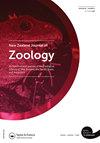Detecting the pest fish, Gambusia affinis from environmental DNA in New Zealand: a comparison of methods
IF 1.1
4区 生物学
Q3 ZOOLOGY
引用次数: 2
Abstract
ABSTRACT We assessed the usefulness of environmental DNA (eDNA) for monitoring the introduced pest fish Gambusia affinis by filtering water samples from streams in the Nelson and Tasman regions, South Island, New Zealand, known to contain G. affinis, and from streams where G. affinis were absent. We used the Smith Root DNA sampler backpack with two types of filters (1.2 and 5 µm pores), to filter water and capture eDNA, and used quantitative polymerase chain reactions (qPCR), and digital droplet PCR (ddPCR) to measure the amount of G. affinis DNA collected by the two filter sizes. We also used high throughput (Illumina MiSeq) sequencing (HTS) to detect G. affinis. Results from the two PCR methods and the high throughput sequencing were compared to hand net counts of G. affinis. We found that all three methods were equally successful at detecting G. affinis when four replicates were taken from each site, but that sensitivity over all replicates was ddPCR > qPCR > HTS. We conclude that the use of environmental DNA to detect the presence of G. affinis is a useful tool to assist in mapping the distribution of G. affinis and will aid in the control of this invasive species.从新西兰的环境DNA中检测有害鱼类:方法的比较
摘要:我们通过过滤新西兰南岛Nelson和Tasman地区溪流中已知含有嗜圆线虫的水样,以及没有嗜圆线虫存在的溪流中的水样,评估了环境DNA(eDNA)对监测引入的有害鱼类嗜圆线虫(Gambusia affinis)的有用性。我们使用了Smith Root DNA采样器背包和两种类型的过滤器(1.2和5 µm孔),以过滤水并捕获eDNA,并使用定量聚合酶链式反应(qPCR)和数字液滴PCR(ddPCR)来测量两种过滤器尺寸收集的亲和G.DNA的量。我们还使用高通量(Illumina MiSeq)测序(HTS)来检测亲和G。将两种PCR方法和高通量测序的结果与亲和G.的手净计数进行比较。我们发现,当从每个位点进行四次重复时,所有三种方法在检测嗜酸乳杆菌方面都同样成功,但所有重复的灵敏度都是ddPCR > qPCR > HTS。我们得出的结论是,使用环境DNA来检测亲和G.的存在是一种有用的工具,有助于绘制亲和G.的分布图,并将有助于控制这种入侵物种。
本文章由计算机程序翻译,如有差异,请以英文原文为准。
求助全文
约1分钟内获得全文
求助全文
来源期刊
CiteScore
2.80
自引率
0.00%
发文量
20
审稿时长
>12 weeks
期刊介绍:
Aims: The diversity of the fauna of the southern continents and oceans is of worldwide interest to researchers in universities, museums, and other centres. The New Zealand Journal of Zoology plays an important role in disseminating information on field-based, experimental, and theoretical research on the zoology of the region.

 求助内容:
求助内容: 应助结果提醒方式:
应助结果提醒方式:


